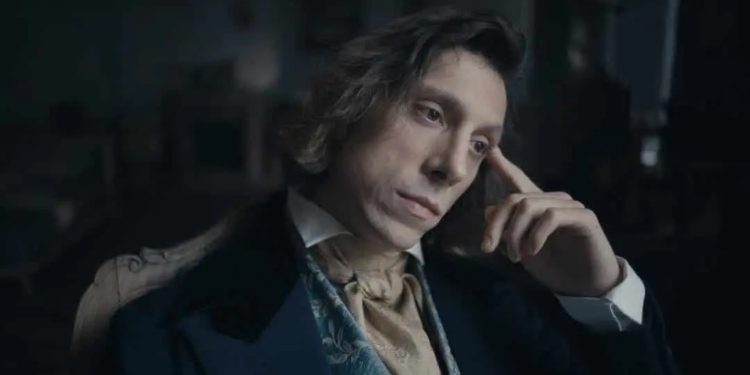Presented out of competition during the 46th edition of the Cairo International Film Festival (CIFF), in the “Special Screenings” section, Chopin, Chopin! by Michał Kwieciński is a period film of sumptuous craftsmanship, but whose visual beauty never seeks to flatter: it serves, on the contrary, to make sensitive the exhaustion of a world. Through the figure of the Polish composer, the filmmaker films a society on the eve of its disappearance, that of Parisian salons, aristocratic rituals and a social order on the verge of faltering.
The film is not a traditional biopic. Kwieciński rejects chronology and linear narration: Chopin, Chopin! is made up of fragments, suspended moments, intimate scenes and social concerts, where music becomes both language and refuge. This choice, risky but coherent, constructs a sensitive portrait of a worn-out man, aware that his art will survive his body. In the lead role, Eryk Kulm plays a fragile, almost erased Chopin, both present and already absent. His performance, all restrained, relies on breathing, silences, the slowness of the gesture, and refuses the emphasis expected of a mythical character.
The story immerses us in 19th century Paris: Chopin, an essential figure of Parisian nights, is adored and admired, the romantic composer par excellence. But the disease advances, his lungs bleed, and he knows his days are numbered. Composing becomes for him both a refuge and a final act of defiance, while the society around him continues to shine, superficial and carefree.
The visual reconstruction, signed by leading Polish artisans, is one of the film’s great successes. The sets, the costumes, the chandeliers, the instruments: everything seems to have been filmed in the light of a rediscovered truth. But this light is never celebration. It illuminates the fatigue, the faces, the shadows that lengthen on the walls. The clarity of public scenes – the salons, the concerts, the social evenings – highlights all the better the approaching night, that of illness, solitude and the end of an era.
Because that’s what it’s all about: the end of a world. The film takes place in post-revolution France, where the aristocracy tries to save the appearances of past greatness. History is there, in the background, not as an event that is recounted, but as a silent threat, an inevitable change that the characters still refuse to name. The French Revolution, without ever being shown, hangs like a shadow over this society which continues to dance, to play, to compose, all the while feeling that the ground is slipping away under its feet.
Kwieciński does not illustrate the facts: he makes them resonate. He chooses to observe the signs of the shift in detail – a look, a cough, a gesture that is too slow – rather than in the great historical fresco. This refusal of the spectacular can be confusing, but this is where the strength of the film lies: Chopin, Chopin! tells of the end of a world through the slow extinction of a man. And, conversely, the disappearance of the composer becomes the allegory of that of a civilization.
Kwieciński explores with remarkable sobriety the tension between genius and fragility. Chopin is never idealized: he is shown as a man struggling against his own body, but above all against the time that escapes him. This acute awareness of the end permeates the entire film, even in its way of approaching creation.
The film returns several times to these unpublished scores that Chopin composed, daring and avant-garde works which he spoke with Franz Liszt, admiring but worried that they would not be understood. At the end, bedridden, Chopin asked that they be burned. The pages delivered to the flames seal this renunciation: not out of vanity, but out of lucidity. Kwieciński films this moment without pathos, like the last act of an artist who prefers to erase rather than see his work betrayed.
This ultimate gesture condenses the meaning of the film: a meditation on memory and the responsibility of the artist in the face of his own heritage. Chopin, aware of what posterity transforms, chooses silence as the ultimate truth.


Music, obviously, runs through the film like living matter. Chopin’s pieces – mazurkas, nocturnes, preludes – do not serve as simple illustration: they become the dramatic thread itself. The camera lingers on the fingers, the breaths, the silences between the notes. We feel the illness, the cough, the effort that each chord requires. The pianist and the filmmaker work hand in hand to transform physical exhaustion into aesthetic movement.
But music is not alone. Kwieciński places Chopin in a social environment that is crumbling: the veneer of conversations, the false lightness of salons, the way in which we applaud without really listening. The film shows this world as a theater stage where everyone clings to a role that has become empty. Chopin, in this, is not only a patient: he is the helpless witness of an era which is dying without daring to admit it.
Visually, Chopin, Chopin! deploys chiaroscuro photography that sometimes evokes Rembrandt or Caravaggio. The light seems filtered through the illness itself: it wavers, trembles, goes out with the pianist’s breath. The aesthetics of the film literally follow the breathing of the filmed body. Kwieciński, already known for his careful productions, here confirms a rare mastery of visual rhythm.
If the film divides, it is precisely because it refuses grandiloquence. Michał Kwieciński never gives in to the temptation of pathos or the romantic image of a Chopin martyred by illness. On the contrary, he chooses a staging of great modesty, almost austere, which makes the character all the more human. This emotional distance, far from a simple stylistic effect, is part of the project: to show an artist confronted with his own disappearance, in a constant tension between the fragility of the body and the permanence of the music.
The film is therefore not a story, but a meditation. He questions what it means to “leave a trace”, about the responsibility of the artist in the face of his times. By filming a composer who passes away while the world around him clings to illusions, Kwieciński constructs a broader reflection on disappearance, memory and beauty. Chopin, Chopin! does not seek to revive the past; he seeks to understand how it fades.
At the end, as the music falls silent, the silence is not absence but continuation. The light, one last time, invades the frame before going out. It is not an end, but a suspension. As if the film, like the composer, was holding its last breath before disappearing – and, in doing so, lasting.
Neila Driss








